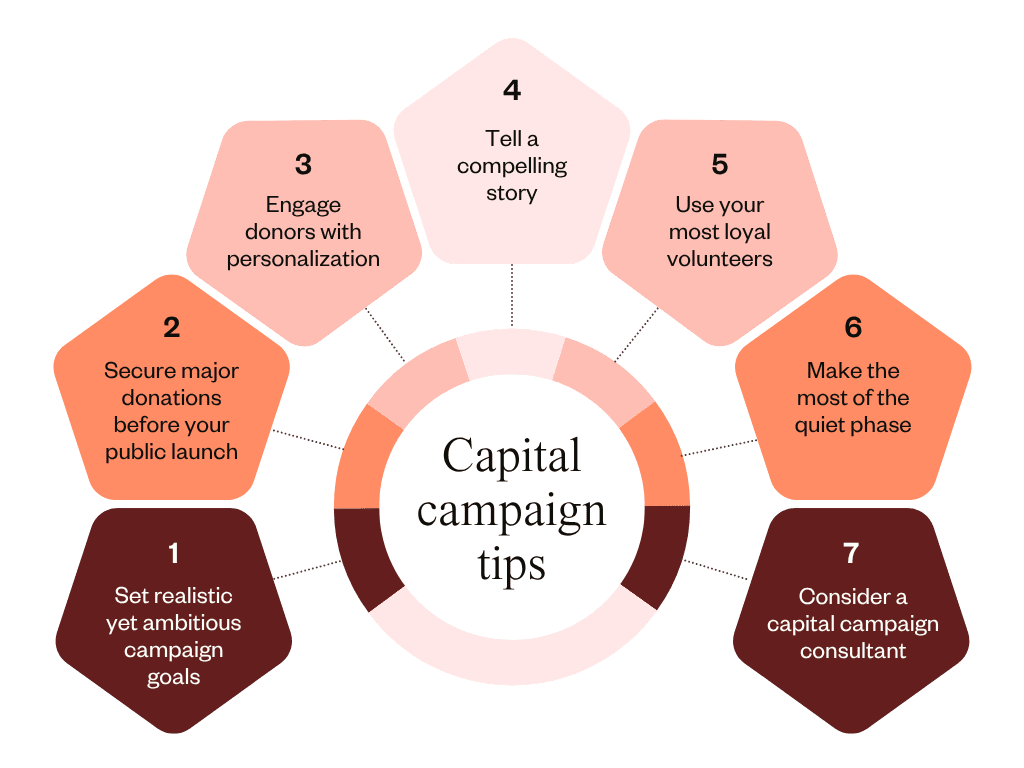
Capital campaigns don’t happen every year, so when you launch one you want it to succeed. But how do you plan, launch, and run a capital campaign that not only reaches your goals but exceeds them?
Whether you’re a seasoned campaign manager or this is your first time running a major campaign, there’s always something you can learn from the success of others. Follow these capital campaign best practices to hit your goals and build a stronger nonprofit in the process.
1. Assemble a strong capital campaign planning and execution team
Behind every successful capital campaign is a dedicated team of staff, board members, and volunteers. With the average nonprofit capital campaign spanning 3-4 years, you need a strong team that can support you from start to finish.
Your campaign planning and execution team handles everything from managing timelines and tracking progress, to donor outreach and relationship building. Assemble your staff members based on their strengths, experience, and ability to work well together.
The size of your campaign team depends on your organization and project, but could include:
- Campaign chair
- Executive leadership team or director of development
- Board members
- Planning committee
- Steering committee
- Staff members — Campaign or project manager, fundraising manager, marketing manager, volunteer coordinator
- Volunteers
- Major donors
As you build your team, look for individuals with strong organizational and communication skills. Include individuals who know how to use fundraising data to plan activities, raise money, and build community support. And passion and enthusiasm matter too—especially in your volunteers.
2. Conduct a capital campaign feasibility study
Before you begin your strategic planning, you first need to make sure your proposed project goals align with your donor’s priorities. Organizations that conducted a feasibility study were twice as likely to build stronger relationships with major donors, which leads to a positive impact on donations.
Your feasibility study allows you to understand the opportunity to raise money from potential donors. It also identifies key donors and volunteers who can play a pivotal role in supporting and championing your campaign.
Most nonprofit organizations hire a capital campaign consultant to take care of this step for them, but with the right tools and knowledge you could conduct the study in-house.
3. Develop a detailed campaign timeline
Capital campaigns require a lot of planning and organization, and a campaign timeline will keep you on track. Establish a clear timeline that spans from start to finish, with key phases and deadlines.
A typical nonprofit capital campaign timeline includes:
- Campaign planning phase
- Implementation (quiet phase)
- Campaign kick-off
- Public phase
- Follow-up and ongoing stewardship
Your campaign timeline doesn’t just guide you on the next steps, it also provides valuable momentum for your project. There may not be noticeable progress every day, but your timeline helps illustrate that you’re moving forward towards your goals.
4. Create a realistic capital campaign fundraising budget
Capital campaigns are expensive. A typical capital project will cost around 10% of your end capital campaign fundraising goal, so it’s essential to set a strict budget and monitor your finances.
Bring your team together to discuss spending, and work out a realistic budget based on available funds. Decide which spending is a priority, how much to allocate to each area, and when you plan to spend those funds.
Common categories for your campaign budget include:
- Professional fees
- Construction materials
- Fundraising events
- Education
- Equipment
- Marketing materials
Remember to account for the unexpected. While you can’t predict every price increase or unforeseen cost, it’s sensible to set aside extra funds for contingencies.
5. Build a strong capital campaign case for support
Donors need a reason to engage with your capital campaign. Your feasibility study shows evidence of interest, but you’ll still need a strong case for support (a.k.a. a case statement).
A case statement explains the need for your capital project and demonstrates how it benefits the community. It becomes a central document that your team and stakeholders can refer to, guiding them on donor prospecting, marketing initiatives, and outreach.
Your case for support should include:
- Overview
- Mission and vision
- Leadership
- Current situation or challenge
- Opportunity or solution
- Project plan and budget
- Project timeline
- Summary
- Contact details
While your original document may be long and detailed, it’s a capital campaign best practice to create more shareable versions for key stakeholders, major donors, and your wider community. Tailor your messaging to each audience for the biggest impact.
6. Prioritize stewardship after the campaign
The work doesn’t end when your successful capital campaign does. Stewardship is crucial for maintaining relationships with donors for future campaigns. As your campaign comes to a close, have a plan ready for how to stay in touch with donors and nurture those relationships.
Effective donor stewardship includes:
- Personalized thank-you messages
- Donor recognition or appreciation events
- Showcasing their impact
- Regular email updates
- Social media shoutouts
- Donation anniversary cards or messages
- Highly personalized communication
Being intentional about stewardship ensures that donors stay committed to your cause beyond a single campaign, helping secure support for future nonprofit fundraising campaigns.
7 Useful tips for your next capital campaign
Build on the foundations of best practice with these expert tips, designed to help you take your future capital campaigns to the next level.

1. Set realistic yet ambitious campaign goals
A clear and compelling capital campaign goal motivates donors to give. Set a goal that aligns with your mission and vision, and the results of your feasibility study. Your goal should be achievable yet feel ambitious, as you want people to encourage as much support as possible.
Under your main goal, create sub-goals or smaller milestones. These interim targets keep momentum going and give you regular wins to celebrate — a must-have in a years-long capital campaign.
Share your goals openly, create gift range charts, and explain to donors how their contributions can help you reach your target. Celebrate milestones, share progress updates, and bring your donors along with you on the journey.
2. Secure major donations before your public launch
The 80/20 rule rings true for capital campaigns, with the top 20 donors accounting for 70-80% of your overall funds. You need these major gifts to reach campaign success, so it’s essential that you solicit and secure them early on.
It’s difficult to get engagement from your wider donor base when you’re starting from zero. A capital project that’s already on its way to being funded is a more attractive option. Engage with your major donors and board members early to bring in those much-needed funds that inspire others to give.
3. Engage donors with personalization
Generic communications won’t cut it for this fundraising effort. Capital campaign best practices call for personalizing your messaging as much as possible, to create targeted, unique, and thoughtful donor outreach.
Tailor engagement strategies to donors’ giving history, interests, and preferred types of communication. Roll out personalization at scale with the help of purpose-built AI, and invest in personal phone calls and handwritten messages for major donors.
This hyper-personalized approach is essential in the quiet phase while you’re engaging major donors, but it’s also effective throughout the public phase and post-campaign phase too. A personal touch motivates individuals to give, and can help you build long-lasting donor relationships.
4. Tell a compelling story
Your goal might be a financial one, but it’s the stories you tell that will captivate donors and inspire them to give. Create a compelling story that illustrates where you are now, what your goal is, and why this project is essential for your community.
Explain how you arrived at the idea for your capital project, and who helped you along the way. Paint a picture of what the future will look like with your new building, community program, new facility, or improved endowment fund in place.
5. Use your most loyal volunteers
Volunteers are a major part of any nonprofit organization, but they’re especially valuable when it comes to capital campaigns. Call on the support of your most loyal, helpful, and talented volunteers to help you pull off a successful campaign.
Onboard key players to your campaign committee, and distribute roles based on experience, enthusiasm, and interest. Give your volunteers access to your case statement and all the materials they need to help you expand your reach and build relationships with donors.
6. Make the most of the quiet phase
The quiet phase is where you’ll draw in the majority of your campaign funds, and the focus is on major donor engagement and solicitation. But there’s more you can do during this long phase, without disclosing your specific plans to the public.
Use this time to prepare campaign materials so you have everything ready for your public phase. Work on stakeholder engagement, especially with your board members. Invite feedback from key contributors and act on it, adjusting your goal, budget, or plan accordingly.
7. Consider bringing in a nonprofit capital campaign consultant
While you can see success with an in-house project team, many nonprofits seek out the expertise of a fundraising consultant — at least for part of the capital campaign process. This external support can be a valuable way to round out your knowledge, complete prospect research, or benefit from leadership in the planning phase.
Determine whether there are any areas of your project that you’d benefit from expert support with, and see whether there’s enough room in the budget to invest. You might even want to raise money to increase your budget, if there’s a likelihood that the investment could lead to a higher chance of fundraising success.
Improve your chances of success with these capital campaign best practices
Capital projects are big, expensive, and incredibly important, which is why your planning process and execution need to be strategic. Use these best practices and expert tips to give you a strong foundation to work with next time you’re planning a capital campaign.
Looking for some inspiration? Check out our list of the top capital campaign fundraising ideas.
Be the first to read our resources.
The world is changing quickly—and our resources help you stay on top of it all. Sign up to get new insights, success stories, and more, sent right to your inbox.




